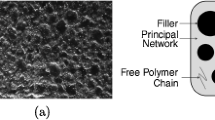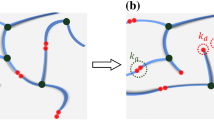Abstract
In this paper constitutive equations are developed for the rheological description of highly filled polymers in which particle-matrix interactions are more significant than interparticle interactions. At any point in the deformation history the polymer chains are classified as either “free” or “trapped” (to the particles), the total stress being assumed to be the sum of the stresses in these two types of chains. When a load is applied to this system, it is hypothesized that a fraction of the trapped chains becomes free, and that simultaneously some free chains become trapped, with a balance between the two described by a deformation rate dependent kinetic equation. The rheological behavior of the free chains is described by stable nonlinear viscoelastic constitutive equations for unfilled polymers. For the trapped chains similar equations are used, but with the relaxation time in the evolution equation scaled by a scalar “mobility” function of the degree of chain debonding from the particles. All the basic features of highly filled systems such as anisotropic yield stresses, thixotropy, and frozen memory during relaxation can be described by this scheme without using any yield criterion. Preliminary comparisons are made with experimental data in simple shear and simple elongation.
Similar content being viewed by others
References
Bingham JC (1922) Fluidity and plasticity. Inter Chem Press, The McGraw Hill Book Company, NY
Coussot P, Leonov AI, Piau JM (1993) Rheology of concentrated dispersed systems in a low molecular weight matrix. J Non-Newtonian Fluid Mech 46:179–217
Doremus P, Piau JM (1991) Yield stress fluid. Structural model and transient shear flow behavior. J Non-Newtonian Fluid Mech 39:335–352
Goodeve CF (1939) A general theory of thixotropy and viscosity. Trans Farad Soc 35:342–358
Hohenemser K, Prager W (1932) Über die Ansätze der Mechanik der Kontinua. Z f AMM 12:216
Hutton JF (1975) On using the Weissenberg rheogoniometer to measure normal stresses in lubricating greases as examples of materials which have a yield stress. Rheol Acta 14:979–992
Joseph DD, Renardy M, Saut JC (1985) Hyperbolicity and change of type in the flow of viscoelastic fluids. Arch Ration Mech Anal 87:213
Joseph DD (1990) Fluid mechanics of viscoelastic liquids. Springer, Berlin Heidelberg New York
Kwon Y, Leonov AI (1992) On 1 D instabilities in simple shear and extensional flows as predicted by some Maxwell-like constitutive equations. J Rheol 36:1515–1528
Kwon Y, Leonov AI (1993) On Hadamard type stability of single-integral constitutive equations for viscoelastic equations. J Non-Newtonian Fluid Mech 47:77–91
Kwon Y, Leonov AI (1994) On instabilities of single integral constitutive equations for viscoelastic liquids. Rheol Acta 33:398–404
Leonov AI (1976) Nonequilibrium thermodynamics and theology of viscoelastic polymer media. Rheol Acta 15:85–98
Leonov AI (1983) Kinematics, quasilinear thermodynamics, and rheology in nonlinear theory of viscoelasticity with the use of recovery strain as an internal parameter. Ann NY Acad Sci 410:23–38
Leonov AI (1987) On a class of constitutive equations for viscoelastic liquids. J Non-Newtonian Fluid Mech 25:1–59
Leonov AI (1988) Extremum principles and exact two side bounds of potential functional and dissipation for slow motions of nonlinear viscoplastic media. J Non-Newtonian Fluid Mech 28:1–28
Leonov AI (1990) On the rheology of filled polymers. J Rheol 34:1039–1068
Leonov AI (1992) Analysis of simple constitutive equations for viscoelastic liquids. J Non-Newtonian Fluid Mech 42:323–349
Metzner AB (1985) Rheology of suspensions in polymer liquids. J Rheol 29:739–775
Oldroyd JG (1947) A rational formulation of the equations of plastic flow for a Bingham solid. Proc Cambridge Phil Soc 43:100–105
Osanaiye G (1994) On the theological properties of suspensions, filled thermoplastics, and rubber compounds. Ph D Dissertation, University of Akron
Osanaiye G, Leonov AI, White JL (1993) Investigations of the theological behavior of rubber-carbon black compounds over a wide range of stresses including very low stresses. J Non-Newtonian Fluid Mech 49:87–101
Papanastasiou TC (1987) Flow of materials with yield. J Rheol 31:385–404
Simhambhatla M (1994) The rheological modeling of simple flows of unfilled and filled polymers. Ph D Dissertation, University of Akron
Simhambhatla M, Leonov AI (1994) On the rheological modeling of viscoelastic polymer liquids with stable constitutive equations. Submitted to Rheol Acta
Slibar A, Paslay PR (1964) On the analytical description of the flow of thixotropic materials. In second order effects in elasticity, plasticity, and fluid dynamics. M Reiner and D. Abir (eds) MacMillan, London
Suetsugu Y, White JL (1984) A theory of thixotropic plastic viscoelastic fluids with a time-dependent yield surface and its comparison to transient and steady state experiments on small particle filled polymer melts. J Non-Newtonian Fluid Mech 14:121–140
Wang MJ, Wolff S (1992) Filler-elastomer interactions. VI. Characterization of carbon blacks by inverse gas chromatography at finite concentration. Rubber Chem Tech 65:890–907
White JL (1979) A plastic-viscoelastic constitutive equation to represent the theological behavior of small particles and polymer melts. J Non-Newtonian Fluid Mech 5:177–190
Wolff S, Wang MJ (1992) Filler-elastomer interactions. IV. The effect of the surface energies of fillers on elastomer reinforcement. Rubber Chem Tech 65:329–342
Author information
Authors and Affiliations
Rights and permissions
About this article
Cite this article
Simhambhatla, M., Leonov, A.I. On the rheological modeling of filled polymers with particle-matrix interactions. Rheol Acta 34, 329–338 (1995). https://doi.org/10.1007/BF00367150
Received:
Accepted:
Issue Date:
DOI: https://doi.org/10.1007/BF00367150




